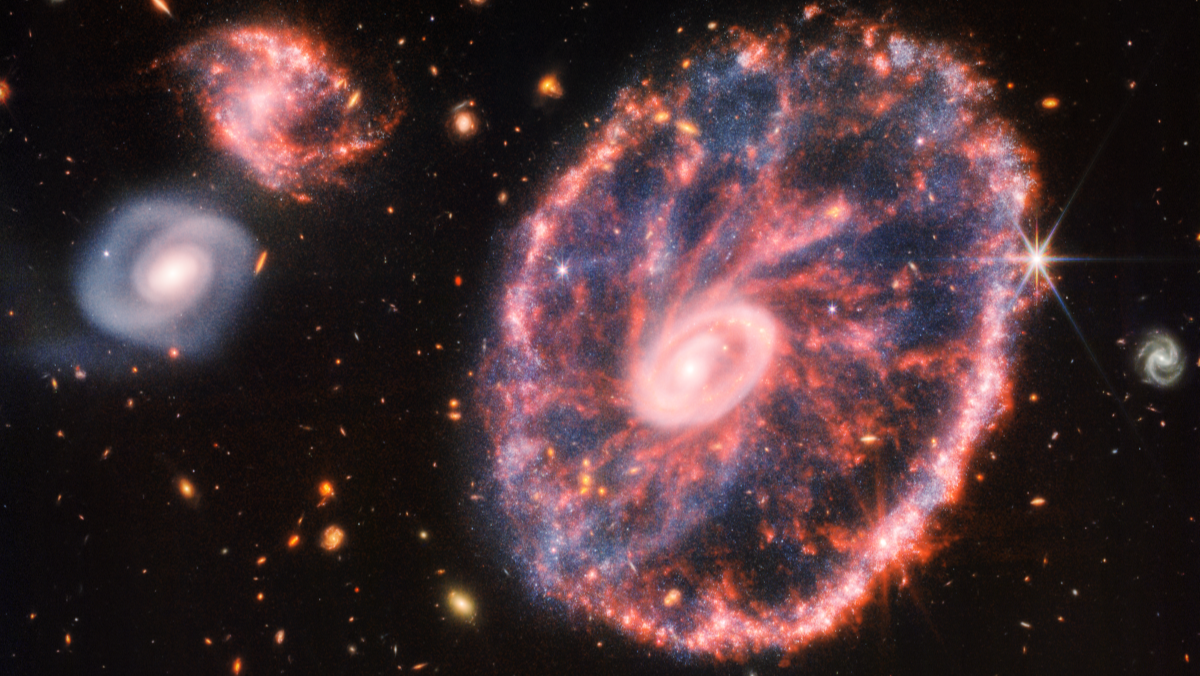The James Webb Space Telescope continues to deliver awe-inspiring images and insights into the universe. Its mirror is six times the size of the Hubble Space Telescope, which has been taking stellar pictures since 1990. But it’s not just about size. The new telescope records infrared wavelengths rather than visible light so it can see farther and more clearly. Older stars appear as bright eight-pointed spikes in the Webb telescope pictures below due to the way the images are taken. But it also adds to the ethereal nature of each image as we peer farther and farther into infinity.
The James Webb Space Telescope Captures the Pillars of Creation

The first image of the Pillars of Creation from the Hubble Space Telescope in 1995 is one of the most widely seen space photos. Now the James Webb Space Telescope adds its remarkable abilities to share even more of the wonder that is the Pillars of Creation with the world. The near-infrared view of this cosmic nursery 6,500 light years away reveals many new details. The red dots seen on the edges of the top pillar are young stars, only a few hundred thousand years old. The red lava-like areas in the other pillars are ejections of hydrogen molecules from still-forming stars. The entire image is eight light years across but represents only a small area of the Eagle Nebula. This image from the James Webb Space Telescope is truly astounding.

In addition, we also got to see a slightly more creepy version of the Pillars of Creation courtesy of the James Webb Space Telescope. This rendition was taken with the telescope’s Mid-Infrared Instrument (MIRI). The first image, meanwhile, was taken with the telescope’s Near-Infrared Camera (NIRCam). This second view allows researchers to see concentrations of gas and dust. But it also makes for another amazing, slightly horror-movie-inspired image from the James Webb Telescope.
Dust Rings Around Binary Stars

The James Webb Space Telescope imaged a system with two enormous stars, each 25-30 times more massive than our Sun. Called Wolf-Rayet 140, their orbits bring them close together about every eight years. The gravitational forces push out a huge dust cloud when that happens. Previous images from ground-based telescopes could see two dust rings, but the new image from JWST shows at least 17. Check out this video from JPL for a visualization of the two stars orbiting each other and a comparison to the older images.
Neptune’s Rings in Focus Courtesy of the JWST

The James Webb Space Telescope has captured the clearest view of Neptune’s ring in more than 30 years. We see the rings and the planet’s fainter dust bands. Neptune system expert and interdisciplinary scientist for Webb Heidi Webb said, “It has been three decades since we last saw these faint, dusty rings, and this is the first time we’ve seen them in the infrared.” This image from the James Webb Space Telescope
Tarantula Nebula

The image above of the Tarantula Nebula is 340 light years across. It introduces us to tens of thousands of stars never seen before because they were lost in the dust of Hubble’s view. The region forms news stars, which appear pale blue. And in case you’re trying to find the eight-legged creature the nebula is named for, apparently it looks like a tarantula’s burrow with silk around the entry, rather than the spider itself. The video below also shows the mid-infrared image from the Webb Telescope. Gases and cosmic dust glow turquoise and purple. It’s beautiful to us casual observers, but adds even more data for astronomers.
The James Webb Space Telescope Reveals the Phantom Galaxy
Also known as M74, the Phantom Galaxy is 32 million light years away in the constellation Pisces. When compared to pictures from the Hubble Space Telescope, the image from the James Webb Space Telescope cuts through the gas and dust to show off the star clusters at the galaxy’s core. Stars and other distant objects are also visible through patches in the arms of the spiral. Combining the images from the two space telescopes gives astronomers the best of both worlds. The visible and infrared light spectrums provide complementary insights into the mesmerizing center of the Phantom Galaxy.

Exoplanet HIP 65426 b
Images of this faraway planet are the first of one outside of our Solar System. Different cameras and filters on the James Webb Space Telescope provide multiple views and insights to astronomers. HIP 65426 b is a gas giant nine times the mass of Jupiter, but we don’t know much more about it yet. Scientists are analyzing all the new data from the Webb Telescope. They removed the light from the planet’s sun using a coronagraph. Once the much brighter star was masked, the faint planet could finally be photographed.
First Images from the JWST

Keep up with the telescope’s Twitter account to see the newest images and research. These include tests taken right here in our own Solar System. Like stunning views of Jupiter, including aurora and some of its many moons. And plenty of distant targets, like the Cartwheel Galaxy and its swirling dust clouds. And of course the first images, including a deep field view that included the oldest and farthest away objects ever photographed.

Originally published September 6, 2022.
Melissa is Nerdist’s science & technology staff writer. She also moderates “science of” panels at conventions and co-hosts Star Warsologies, a podcast about science and Star Wars. Follow her on Twitter @melissatruth.
The post NASA Reveals New Pictures From the James Webb Space Telescope appeared first on Nerdist.
Source: Keulisyuna
0 Comments